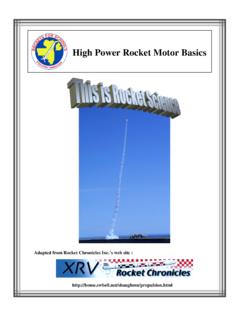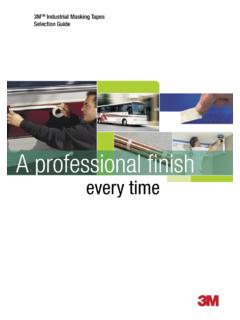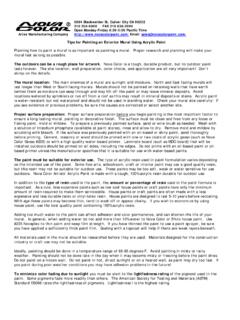Transcription of RFS Class I Rocket Assembly Instructions
1 Instructions & Photos by: Great Lakes Space Port Sheboygan Education Foundation, Inc. RFS Class I Rocket Assembly Instructions Additional Items and Supplies You Will Need 150 Grit & 220 Grit Sandpaper 3/32 , 5/32 , 3/16 drill Bits and Drill 3/4 Masking Tape Plastic Gloves Ruler Pencil Primer Paint General Assembly Tips (PLEASE READ) Before you start building your Rocket , familiarize yourself with these Instructions and the proper sequence of Assembly steps as outlined. This Rocket is flown with high-impulse Rocket motors.
2 For maximum strength and model integrity you must use the supplied epoxy throughout its entire construction unless noted otherwise. IMPORTANT: Before epoxying any parts to the phenolic tubing, make sure you rough it up by sanding the mating surfaces with 150 grit sandpaper to create a better bond. Test fit all components prior to bonding them together with epoxy. Some components may require light sanding to ensure a proper fit. Welcome and thank you for joining the Rockets for Schools Competition We have developed these expanded Instructions for those of you who may not have much mod-eling experience.
3 If you have any problems during your Rocket s construction, feel free to call me with your questions. Randy Lutz Daytime Phone Co-Director Evening Phone Rockets for Schools ID No. Quant. Description 1 1 36 length / 4 diameter Pre-slotted Booster Tube 2 1 18 length / 4 diameter Payload Tube 3 1 12 length / 38mm dia. Motor Tube 4 1 6 length payload coupler 5 1 Plastic Nose Cone 6 3 .093 G-10 Fiberglass Fins 7 1 Payload Bulkhead 8 1 Forward Centering Ring 9 1 Aft Centering Ring 10 1 28 Round Nylon Parachute 11 1 5/8 Wide Tubular Nylon Cord 12 1 Bag Hardware Not Shown: 1 5 Minute Epoxy Step #1 Parts Identification Layout all the parts from the kit and identify them with the parts list below Step #2 Assembly of the Motor Tube Take the Aft centering ring and insert the 1/4 T-nut in the hole as shown.
4 Use a hammer to pound the T-nut flush with the front of the centering ring. The flange of the T-nut may not sit flush on the centering ring. Dab some epoxy on the T-nut flanges to ensure they do not back out of the holes. Do not get epoxy in the threaded holes of the T-nut. Mount an eyebolt through the 1/4 hole in the Forward Centering Ring. Install a nut / small washer on the top side of the centering ring and a small washer / nut on the bottom. Tighten the nuts and secure both nuts with a drop of epoxy.
5 Test fit the centering rings onto the motor tube. Sand as necessary to insure a secure fit. Position the forward centering ring 1/4 inch from the end of the motor tube. Apply a fillet of epoxy on both sides of the forward centering ring where it meets the motor tube. Do not epoxy the Aft centering ring at this time! Set the Motor tube aside to let the epoxy cure. Attach the 25 ft. shock cord to the Forward Centering Ring by passing the loop at one end of the shock cord through the eye-bolt in the Front Centering Ring.
6 Now pass the rest of the shock cord through the loop and pull snug. Place a little epoxy on the knot to secure it. Step #3 Mounting the Motor Tube in the Airframe Now place the shock cord into the motor tube to keep it out of the way for the next step. Start out by mixing up some epoxy. Using a stick or similar item apply a ring of epoxy 11 from the AFT end of the Booster Tube. The aft end of the tube contains the slots for the fins to be added later. Position the Forward Centering Ring into the AFT end of the Booster Tube.
7 You can now slide the motor mount Assembly up the airframe. Double-check that the motor tube is flush with the AFT end of the airframe. Do NOT epoxy the AFT centering at this time! Stand the airframe up-right and allow the epoxy to cure. Apply an epoxy bead to the root edge of the fin. Push the root edge of the fin through the slot in the airframe onto the motor tube. Make sure the fin is perpendicular to the airframe as shown. Step #4 Attaching the Fins Use masking tape to hold the fin in position while the epoxy cures.
8 Repeat this process for all fins. Allow the epoxy to fully cure before proceed-ing to the next step. Apply an epoxy fillet to both sides of each fin where the fin meets the exterior part of the airframe. Put on a pair of plastic or rubber gloves. Dip your finger in rubbing alcohol and carefully smooth each epoxy fillet with your finger before it starts to cure. Allow the epoxy to fully cure before rotating the Rocket to do the next set of fillets. When the epoxy is fully cured sand with 220 grit sand paper.
9 This gives better adhesion when the primer is ap-plied. Screw the 1/4 motor retainer bolt into the T-nut and pull off the aft centering ring. Using a stick or similar item apply an internal epoxy fillet to the root edge of every fin. Allow the epoxy to fully cure be-fore rotating the Rocket to do the next set of fillets. Step #5 Installing the Rail Buttons For additional safety at launch, we are now using rail buttons instead of launch lugs. Note: You must tape off the rail buttons when you paint your Rocket - any paint on the rail buttons may in-terfere with their operation.
10 Place a ruler against the aft end of the Rocket as shown. Mark a spot half way between the two fins. Using a straight edge (a yard stick works well) site down the body tube and draw a line parallel to the center axis of the tube. It s very important that this step is done correctly. If the fins are not attached securely, your Rocket will not pass the safely check. When all the fillets are complete, you should be able to flex the end of each fin back and forth with out breaking them loose from the motor tube.











